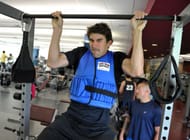Michael Phelps won another Gold medal today. Scratch that, he won two. Both his medals came in the span of 70 minutes.
His ability to come back from his hiatus post London 2012 to come back to add to his haul of 22 overall medals at the 2016 Olympics at Rio was never in doubt, and he’s already shown that with 3 Gold medals so far.
Success like that does not come overnight, nor does one achieve legendary status based on pure talent. As was rightly said by the scientist Thomas Alva Edison, “Genius is 99% perspiraton, 1% inspiration. “
The fact the Michael Phelps rules the pool is a combination of his natural talent, his inclination to work hard during training and the winning mentality he posseses.
Talent sometimes comes from within, as in this case, and a mentality is something one can cultivate. However, the work in training that an athlete puts in is what differentiates the winners from the also-rans.
One glance at the Baltimore native and it is clear he is an athlete with a very rare physique. For one, he is blessed with the torso of a man who is 6’8” tall, though he is only 6’4” tall.
His incredibly flexible, double-jointed knees and size 14 feet help him exert a lot of force while in the water, as he pushes the water back continously.
What helps differentiate him from others is his superior training, as his endurance is so high that the rate of generation of lactic acid in his body is much slower, resulting in fatigue setting in much later.
The fitness regime that has got Phelps here
Warning – This is not for the faint of heart. The combination of cardiovascular exercises and weight training that the American has practised throughout his career show his dedication to the perfection of his craft.
Phelps has always been someone who believes in doing weights along with cardiovascular training, as he has focused only on building a lean, muscular body that helps him perform better in the pool.
At the age of 19, the swimmer used to be put through a series of exercises, which included jackknife crunches that helped improve circulation and muscle function, as the torso muscularity is enhanced. A series of repetitions of bodyweight pull-ups and chin-ups also help shape his physique to perfection.
To improve his pace in the pool and to allow for better breathing, he goes through successive distances of 50m, 100m, 150m and 200m, with only 30 seconds of rest in between each split.
He then does the four distances in reverse order, this time at all-out pace. The emphasis on the earlier, slower stint is to allow acclimitization, which can then help him go faster.
In addition to these endurance improving exercises, he always practises vertical kicking and underwater kicking, both of which help him improve his speed.
To keep his body fit when he isn’t in the water, he does a lot of crossfit exercises, focusing on combining weights with running, specifically doing bodyweight exercises like push ups and weighted pull-ups, which help him stay lean and yet, build muscle, helping him improve on his speed.
Obviously, now, at the age of 31, he doesn’t follow the schedule with the same level of rigour, moving to two to four hour training days, compared to the five to six hour training sessions he used to have earlier.
However, the intensity of Phelps’ training is still very, very high, and is clearly more than enough to keep him performing in the same vein, the proof being the 3 Gold medals he has won so far at Rio 2016.
Phelps’ diet – what drives the phenomenon?
If his training routine was scary, his diet will leave you stunned! Michael Phelps, at the peak of his strict diet planning, used to consume around 12000 calories in a day. Yes, you read that right.
12000 calories a day amounts to 4000 calories per meal. His breakfast usually consisted of three fried egg sandwiches with mayonnaise, lettuce, tomato, low fat cheese and fried onions.
Post that, he used to eat an omlet, 1 bowl of grits, 3 slices of french toast with powdered sugar, 3 chocolate chip pancakes and 1 cup of coffee.
After that humongous breakfast, he proceeds to have an enormous lunch and dinner as well, which included a couple of ham and cheese sandwiches, 1000 calories of energy drinks, two pounds of pasta and a pizza!
In the lead up to London 2012, he relaxed on his carbohydrate rich diet to focus on a more protein-based diet, still very energy rich, to improve his digestion and to keep his body muscular.
After having won 3 Gold medals at the Olympics in 2016, he still has two events to go, and it doesn’t look like he has any competitor who can challenge him.
His training regime and diet is still quite similar to what he used to follow, but as is clear after going through the details, he trains extensively and very vigourously, and at the same time, consumes a lot of food, all so that he can remain in the best shape possible.
If Michael Phelps’ Olympic exploits make you want to take up swimming and fitness seriously, visit the #RiseAtRio themed Flipkart store and start your fitness learning today!


